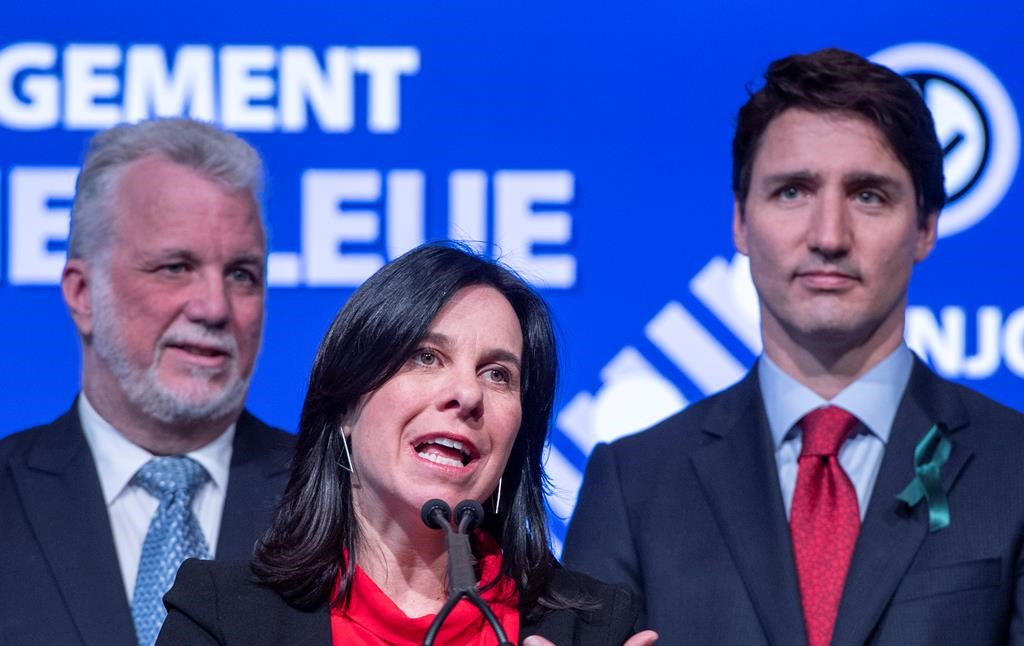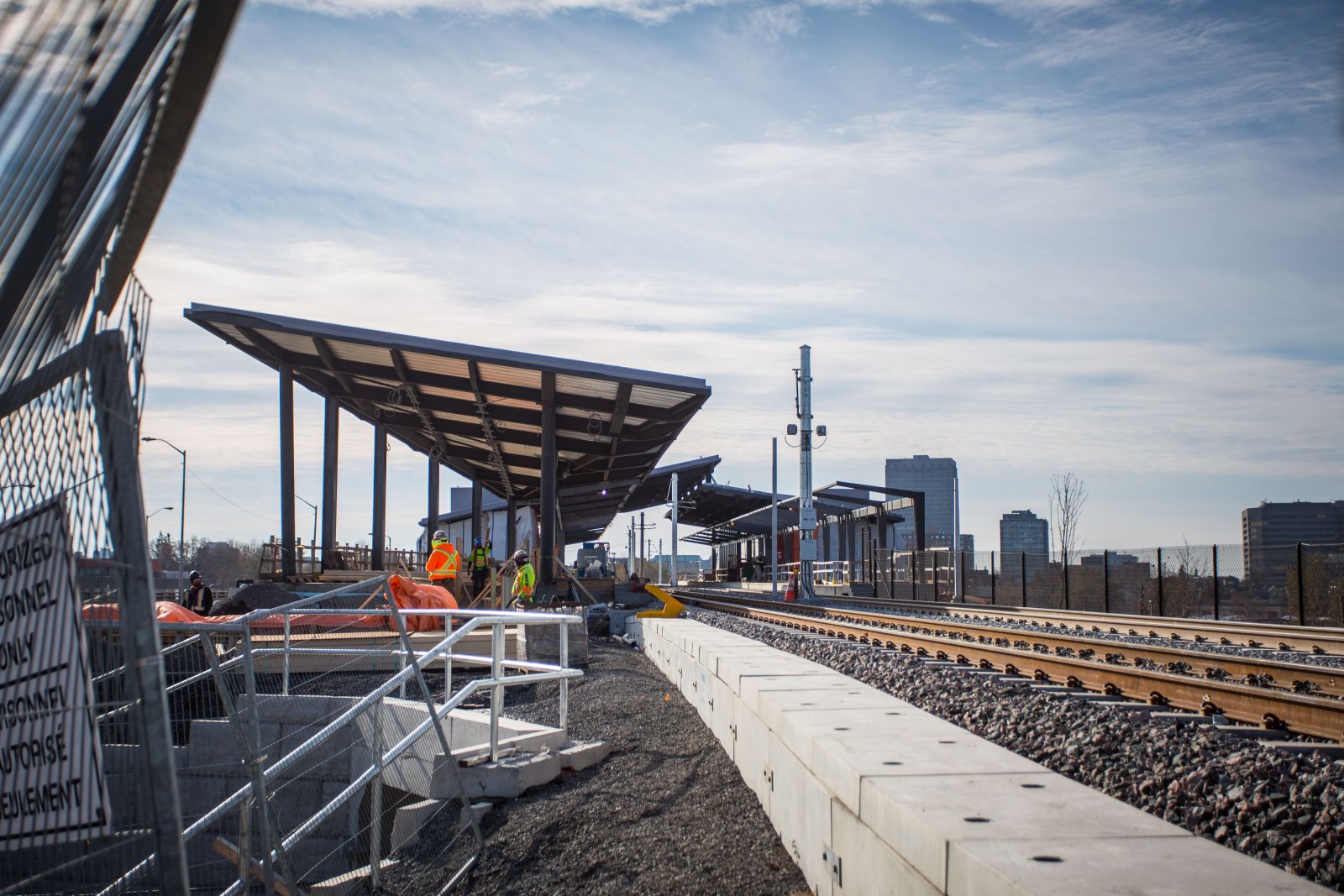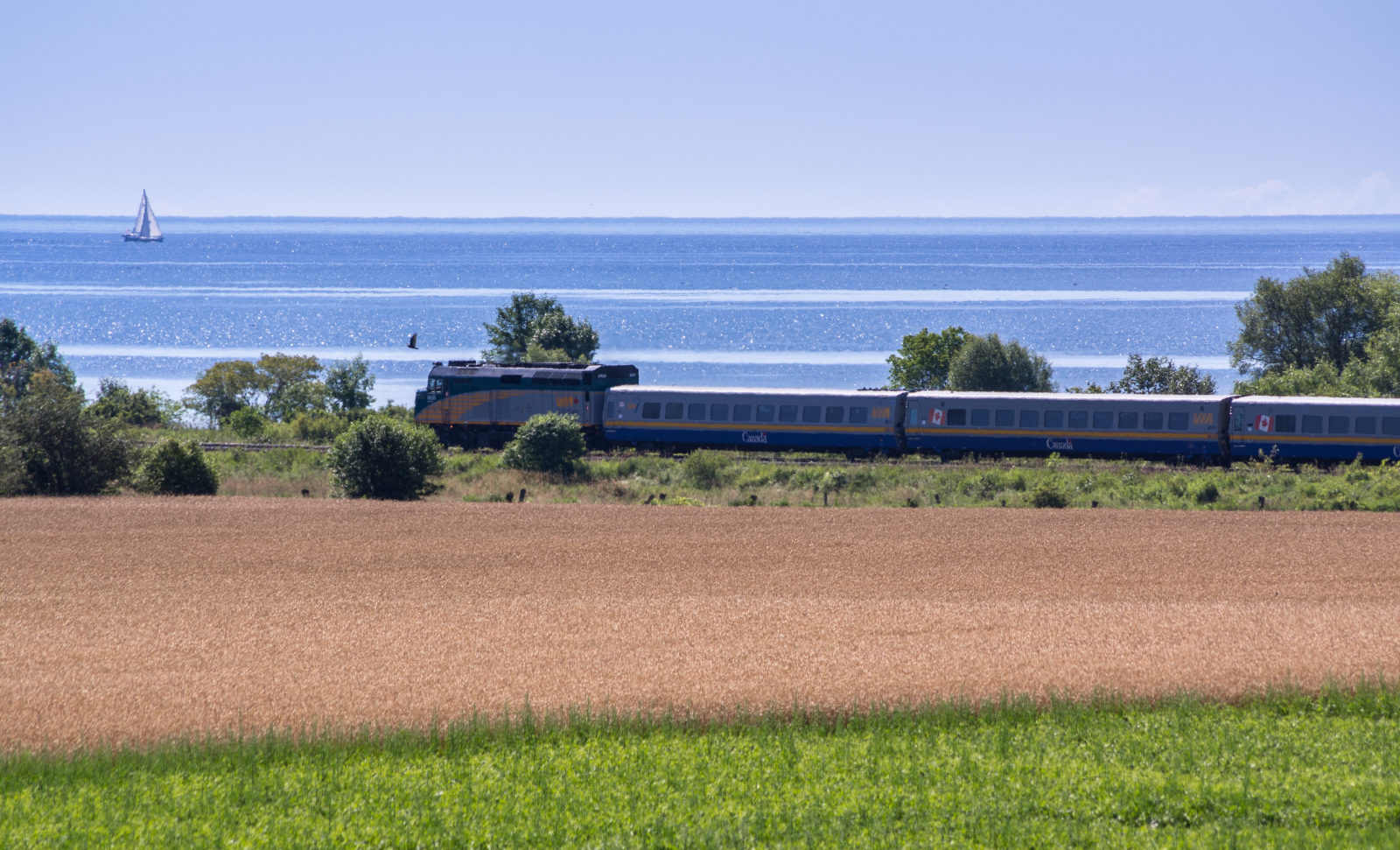
Salwan Bahia smiled warmly on a cold winter day.
“It’ll be a lot more convenient,” said the 18-year old university student, as he waited for his bus from a downtown Ottawa shopping mall on Dec. 18, 2017. “There’ll be no more traffic, so it’ll be better for me.”
Transit advocacy groups say it’s the first time Canada has had such a long-term, dedicated program for public transit. #cdnpoli
“It’ll definitely shorten the commute time so it’s not as tiring,” chimed in fellow student Nihar Dave, standing beside him.
Nearby, 36-year-old economist Beryl Li said she was “absolutely” excited: “The buses get all piled up…and the whole downtown core is just jammed.”
A bus pulled up, featuring a bright red advertisement aboard that proclaimed: “Ready for rail.”
Bahia, Dave, Li and many others were ready then. But months later, Ottawa’s light rail transit (LRT) Confederation Line remains under construction.
The LRT is the “largest transportation infrastructure project” since the storied Rideau Canal was built in the 19th century, according to the City of Ottawa.
Once it’s built, the city says it will reduce hundreds of thousands of tonnes of carbon pollution, save millions of litres of fuel, cut air contaminants and traffic congestion, and spur local green jobs growth and job training.
The 12.5-kilometre project has received financial backing from municipal, provincial and federal governments and its construction of the track, a downtown 2.5-kilometre tunnel, and 13 stations is progressing.
But the project has been beset by delays and finger-pointing over a sinkhole that emerged along its route in 2016 — a complicated path to completion that illustrates a recurring theme. By many accounts, major public transit projects are a ticket to green growth, but only if they can stay on track.

The fine details of federal funding
Prime Minister Justin Trudeau’s Liberals have promised a total of $1.92 billion in federal funding for both phases of the Confederation Line, as part of a 12-year, $180-billion plan to kickstart major infrastructure projects in cities across the country. Transit advocacy groups say it’s the first time Canada has had such a long-term, dedicated program for public transit.
The government said its investment will shift cities to clean growth, create more inclusive communities, and build “world class public transit systems” within a decade. “Our communities will also be cleaner, and less reliant on sources of energy that pollute the air, harm the environment and compromise Canadians’ health,” promised the 2017 budget.
But most of this money isn’t out the door yet. This year’s budget noted that the government is finalizing negotiations with the provinces and territories to distribute infrastructure funding.
Infrastructure Minister Amarjeet Sohi missed his self-imposed March deadline to reach funding deals on infrastructure, including transit, with provinces and territories. But he insisted it was just a matter of finding the time to sign. The Monday after, he did reach a deal with B.C. over $4.1-billion in funding, in part for transit.
The federal Liberals and the BC NDP government will each cover 40 per cent of the project costs, while the cities involved in the transit projects will fill the remaining gap with fares or taxes.
Trudeau highlighted another transit project this week when he appeared in Montreal with Premier Philippe Couillard and Mayor Valérie Plante to announce $365 million to extend the métro’s Blue Line for five stops, due in 2026. But Quebec and Ottawa are “still negotiating how the bill will be split,” the Montreal Gazette reported.
Plante made transit issues a centrepiece of her mayoral campaign, proposing a 29-kilometre Pink Line that would connect Montreal North with the downtown and neighbourhoods further south and west. She said she would continue to push for the Pink Line.
Federal funding for infrastructure is also delivered as reimbursements for projects once they’re completed. Ottawa typically ponies up its share last, reimbursing provinces and municipalities. About one-quarter of infrastructure funds aren’t spent in the year they’re budgeted, according to The Canadian Press. Cities sometimes find themselves at risk of losing money allocated for infrastructure because they haven’t spent it yet.
The Parliamentary Budget Officer (PBO) reported March 29 that the federal government could identify $7.2 billion worth of approved projects initiated in either 2016-17 or 2017-18, and a further $7.2 billion, or roughly half of the total, had not yet been attributed.
Responding to the PBO report, Sohi’s spokesman said Canadians are benefiting from the projects under the first phase of the government’s infrastructure plan “after a decade of absence by the previous government.”
“These projects are creating economic growth, as noted by the Bank of Canada, and opportunities for Canadians as we build healthy, livable and sustainable communities,” Brook Simpson wrote in an email.
“We are committed to being transparent with Canadians and Parliament in how we make and communicate our investments and are working to ensure all necessary information is provided across departments when requested.”

Major projects could bring political risk
Even if a chunk of funding for a transit project can clear bureaucratic hoops, it sometimes risks becoming ensnared in politics.
Ottawans have had transit funding dangled in front of them, only to see it yanked away. Their outgoing city council, for example, had approved a transit line more than a decade ago, but the money was withheld federally until after a municipal election, so the new council could have a chance to vote on it for themselves. When they did end up voting, they rejected the plan.
Another example is former Toronto mayor Rob Ford’s 2010 cancellation of an extensive public transit plan for that city, dreamed up by his predecessor.
Jason Kenney, leader of the opposition United Conservative Party in Alberta, gave a preview for what this could look like on the West Coast, when he suggested that the federal government’s support for the Trans Mountain oil pipeline extension should be viewed through the lens of its infrastructure deal with British Columbia, whose government opposes the pipeline.
“Justin Trudeau claims that he’s been fighting for (the) Trans Mountain pipeline. But just days ago, his (government) signed a $4.1 billion infrastructure deal (with) the BC NDP, the same (government) that’s been working to block the pipeline for months,” he wrote on Twitter.

Tricky to track green benefits
Environmental benefits are expected to come built-in with several federal transit infrastructure upgrades across the country.
Jeff Mackey, public policy co-ordinator at the Canadian Urban Transit Association, said initiatives across Canada are poised to benefit environmentally from the federal infrastructure funding already committed.
He pointed to several initiatives: $111 million to Calgary’s Green Line LRT, through four separate funding commitments; $5.47 million to Victoria to improve resilience against seismic activity; $10 million to Gatineau, Que. for new hybrid buses; $10 million to Laval, Que. for 22 hybrid buses and new electric charging infrastructure; and $572,500 for hybrid bus upgrades in London, Ont.
“The projects themselves range from new garage doors or reflective signage to major subway rehabilitation projects, rapid transit fleet expansions and the planning, engineering and building of major transit projects like the Green Line,” he wrote in a Nov. 14, 2017 email.
“From an environmental perspective, not only are we seeing further adoption of alternative propulsion technologies — electric, hybrid, compressed natural gas — in transit fleets, but these changes make it easier, more reliable and more comfortable for Canadians to…shift away from their single-occupancy vehicle towards sustainable mobility options.”
The first phase of the federal transit infrastructure funding, in 2016, went mostly to repairs or upgrades of existing infrastructure. But Mackey argued it also spurred major developments, like the Mayors’ Council on Regional Transportation’s 10-Year Vision for Vancouver, a long-term plan that includes a new subway line, light-rail and system upgrades.
Vancouver Mayor Gregor Robertson, however, won’t be around to see the plan through: he announced in January that he would not seek re-election, and it’s unclear yet who might replace him.
Infrastructure Canada has a list of all national projects proposed since 2002, and their federal funding commitment. The 13,074 total entries in the list of national projects can be hard to track for the average Canadian, said Ryan Katz-Rosene, assistant professor of political studies at the University of Ottawa who studies sustainable transportation.
The federal government’s “massive capitalization” of transit infrastructure in 2016 and 2017 in particular is “in some ways a little bit all over the map,” he said in an interview Nov. 9, 2017.
“It’s a bit of a nightmare and a headache to go through and try to figure out how much money is put into category A,B,C, D on the many different areas,” he said. “The listing of where that money’s going and what specific project is pretty sparse.”
Katz-Rosene said tracking any single transit funding initiative for its environmental benefits is also difficult without specifically zeroing in on a project, looking at the impacts and conducting specific research like road studies.
“This is such a diffuse nature of financing,” he said. “There are so many different components, and multi-year components. And it’s going all over the country, to hundreds of different municipalities.”

Cleaning air, clearing traffic
Waiting for her bus at the Rideau Centre stop, standing opposite students Bahia and Dave, was a former civil servant.
Hope Dudene, who retired 20 years ago, said she’ll be glad when Ottawa’s LRT is completed — she believed it was long overdue. But she was also prepared for it to upend her typical route.
“It’s going to change things for me, in as much as, I won’t be able to come right downtown,” said Dudene. “I live in the west end (of town), so I’m going to have to bus…and then switch (to the train). Whereas now, I can come right downtown on the bus.”
The additional transfer is by design. The city hopes it will clean air and clear traffic downtown during rush hour by re-aligning bus routes so they link up with one of 13 stations being built along the new Confederation Line. The line will be served with 17 two-car trains, the city says, up to 10,700 passengers per hour, in each direction.
This shift from a transit system centered around bus transit to one anchored around an east-west light rail line should take about half of all downtown-destination buses off the road, said Chris Swail, director of planning for the City of Ottawa’s rail transit system, called O-Train.
“There are some significant (greenhouse gas) reductions in that,” he said in an interview at City Hall on Oct. 24, 2017.
How significant they would be is unclear, as the carbon emissions savings projected by the city don’t include reductions expected to come with downtown bus route changes.
Instead, the greenhouse gases that Ottawa’s LRT is expected to reduce are calculated by modelling future projections of ridership, and how those riders might cut into the city’s estimated 14,000 automobile trips annually, said Swail.
“For the most part, they look at where the growth is going to be, proximity to the [train] line, and they also look at things like parking, the price of gas — all of those assumptions go into the model and it basically spits out the amount of cars that are not going to be on the road,” he said.
Ottawa’s estimate of how many tonnes of greenhouse gases it will save by installing the LRT has varied over the years.
The city’s 2012 document promoting the first stage of the LRT — the one being built right now — said the Confederation Line should reduce about 94,000 tonnes of carbon dioxide by 2031, as well as reduce air contaminants like carbon monoxide and nitrous oxides by about 4,600 tonnes that same year.
The 2015 business case document for the project’s second stage — with construction planned to start in 2019 — estimated it would cut carbon pollution by 155,500 tonnes, create “over 67 million litres of savings in fuel consumption,” and reduce air contaminants by 4,363 tonnes by 2048.
Ottawa’s 2018 budget puts the numbers at “110,000 tonnes per year by 2048″ of carbon pollution and 3,000 tonnes of contaminants by the same year.
To put that in perspective, some of the biggest manufacturing or industrial plants in Ontario emit greenhouse gases in the millions of tonnes per year. Still, the city’s budget said it will save $32 million per year in environmental benefits.

Considering battery storage
The Confederation Line cars will draw their power from an overhead electric system, instead of the diesel-powered cars currently running on a small north-south Ottawa line.
“One of our biggest concerns is, we pay to operate the system, so we wanted to have a train that was as efficient as possible, and the trains that each proponents bid on were scored based on that efficiency,” said Swail.
“Anytime you can avoid or reduce your energy costs, that’s a greener project, but it also benefits the city in terms of reducing its overall operating costs. They go hand in hand.”
Electric motors can also be designed to capture a vehicle’s forward motion to charge a battery. The LRT vehicles in Ottawa will have such technology, called regenerative braking, said Swail.
He said the city is also considering running the trains partially on battery power.
That would follow in the footsteps of the $5.3-billion Eglinton-Crosstown LRT line in Toronto. One of the largest projects in the country, the 19-kilometre Eglinton-Crosstown is expected to complete work on its 25 stations and stops in 2021.
In February, the Province of Ontario announced that Toronto Hydro has entered into an agreement with Renewable Energy Systems Canada Inc. to design and build its battery energy storage facility.
An advantage of running an LRT system with batteries for a period of time, said Swail, is that it lets the system avoid being dinged during peak electricity hours.
The battery facility would be charged by drawing power from the main grid, but also potentially with renewable power from, for example, solar panels placed upon LRT infrastructure. The maintenance and storage facility the city is considering for its next stage of light rail development could also have this, he added.
This kind of planning growth should, in theory, foster the development of local job training in green construction.
Ottawa’s LRT is expected to create about 24,000 “person-years” of employment, a term used to estimate how much work is done by individuals during a typical day in the field, over the course of a year, but may not equate job numbers.
Plus, most of those jobs are on the construction side, not necessarily translating into permanent jobs once the LRT is up and running. But if the city moves to implement solar panels or green roofs on LRT infrastructure, it could inspire other green building — the development of an eco-friendly cottage industry, for example.
“You have essentially a workforce that is learning how to integrate those technologies into built form and can carry on that project to other things,” Swail explained. “There’s a real [opportunity] for a workforce to become more educated in the deployment of those technologies in Ottawa, which is great for Ottawa in terms of maintaining a competitive advantage.”
These types of workers are scarce, he argued, and are not currently in high demand outside of areas where there are high amounts of infrastructure investment like Ottawa.
But those green roofs or solar roofs won’t be seen for years, until the city starts building its second stage of LRT. At that point, Swail said Ottawa is planning on hosting a “showcase” of green technologies to the developers.

A regional rail promise, still years out
One element left out of all this municipal LRT planning is regional transportation. Canada’s recent federal transit plans have largely focused on cities, noted Katz-Rosene of the University of Ottawa.
In Canada, regional transportation often means VIA Rail, the Crown corporation passenger rail service. VIA Rail promotes itself as a “green choice,” or an “alternative means of travel that is respectful of the environment.” While motorists produce 13 per cent of all greenhouse gas emissions, VIA boasts only 0.03 per cent.
“There’s so much potential for passenger rail, especially in the Quebec-Windsor corridor,” said Katz-Rosene. VIA would be more effective if it had its own track rights, and did more high-frequency trips, he said.
The 2018 budget did allocate $8 million through 2021 for a “continued in-depth assessment” of VIA Rail’s “high-frequency rail” proposal for transportation from Toronto to Quebec City. Last week, an official from VIA said that project was “pretty much going forward,” according to the Peterborough Examiner.
Even with regional rail funding, trains still compete with cars and airplanes to move Canadians around the country, noted Katz-Rosene.
“Canadians travel a lot, we live in a big country, and there’s no real easy solutions,” he said.
Editor’s note: This story was updated at 1 p.m. ET on April 11, 2018 to include remarks from the federal infrastructure minister’s office.
 TheBulletin.ca Journal of Downtown Toronto
TheBulletin.ca Journal of Downtown Toronto
